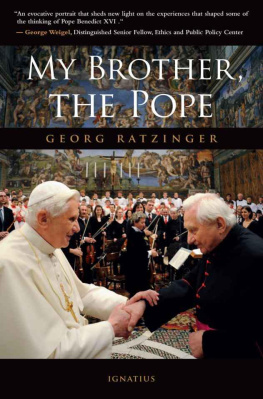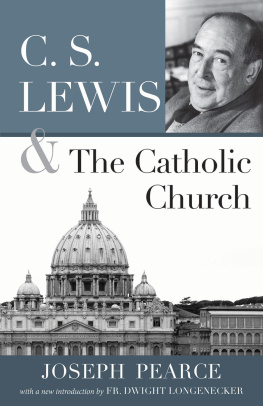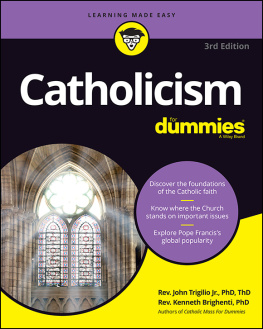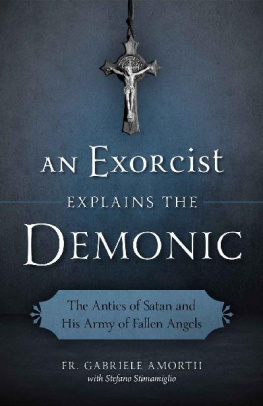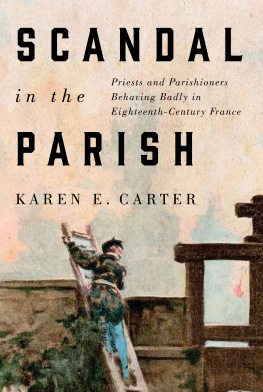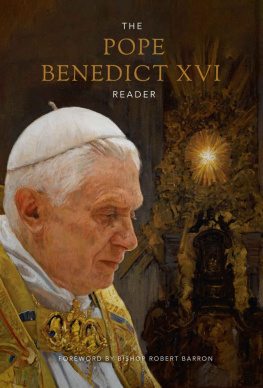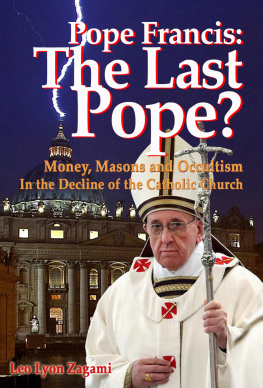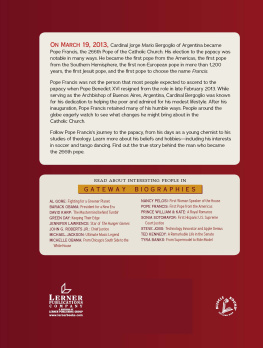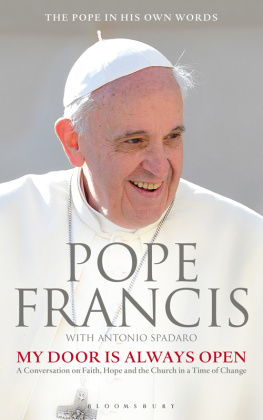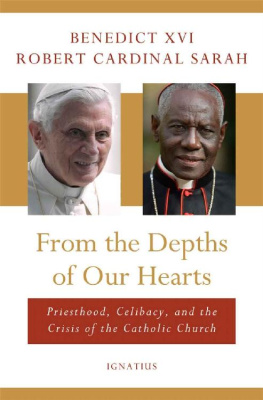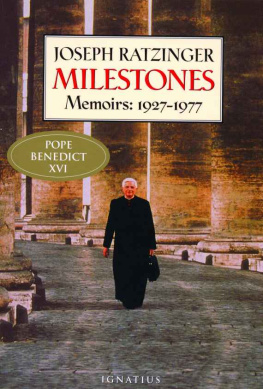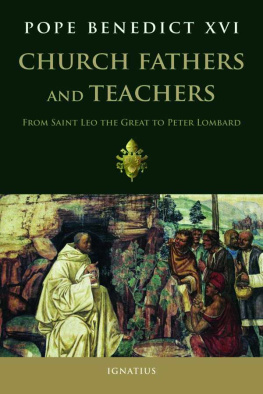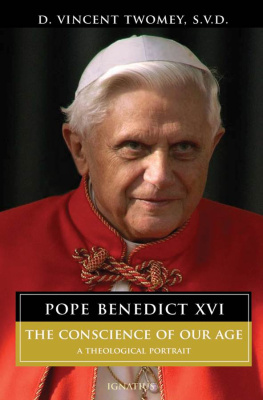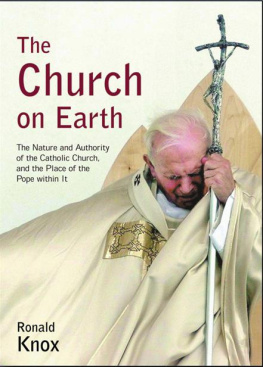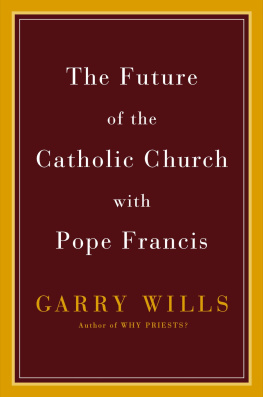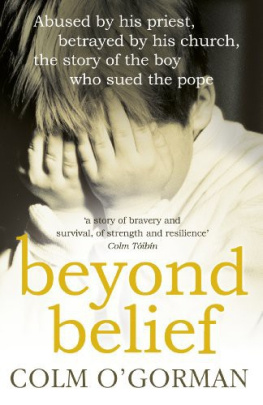Catholic Church - My Brother, the Pope
Here you can read online Catholic Church - My Brother, the Pope full text of the book (entire story) in english for free. Download pdf and epub, get meaning, cover and reviews about this ebook. City: San Francisco, year: 2011;2012, publisher: Ignatius Press, genre: Non-fiction. Description of the work, (preface) as well as reviews are available. Best literature library LitArk.com created for fans of good reading and offers a wide selection of genres:
Romance novel
Science fiction
Adventure
Detective
Science
History
Home and family
Prose
Art
Politics
Computer
Non-fiction
Religion
Business
Children
Humor
Choose a favorite category and find really read worthwhile books. Enjoy immersion in the world of imagination, feel the emotions of the characters or learn something new for yourself, make an fascinating discovery.
- Book:My Brother, the Pope
- Author:
- Publisher:Ignatius Press
- Genre:
- Year:2011;2012
- City:San Francisco
- Rating:4 / 5
- Favourites:Add to favourites
- Your mark:
- 80
- 1
- 2
- 3
- 4
- 5
My Brother, the Pope: summary, description and annotation
We offer to read an annotation, description, summary or preface (depends on what the author of the book "My Brother, the Pope" wrote himself). If you haven't found the necessary information about the book — write in the comments, we will try to find it.
My Brother, the Pope — read online for free the complete book (whole text) full work
Below is the text of the book, divided by pages. System saving the place of the last page read, allows you to conveniently read the book "My Brother, the Pope" online for free, without having to search again every time where you left off. Put a bookmark, and you can go to the page where you finished reading at any time.
Font size:
Interval:
Bookmark:
My Brother, the Pope
Georg Ratzinger
As told to
Michael Hesemann
Translated by Michael J. Miller
IGNATIUS PRESS SAN FRANCISCO
Original German edition:
Mein Bruder, der Papst
2011 by F. A. Herbig Verlag, Munich
Cover photograph:
With the Domspatzen in the Sistine Chapel:
Pope Benedict XVI thanks his brother, Msgr. Georg Ratzinger
LOsservatore Romano
Cover design by Roxanne Mei Lum
2011 by Ignatius Press, San Francisco
All rights reserved
ISBN 978-1-58617-704-1
Library of Congress Control Number 2011940712
Printed in the United States of America
From the beginning of my life, my brother has always been for me not only a companion, but also a trustworthy guide. For me he has been a point of orientation and of reference with the clarity and determination of his decisions. He has always shown me the path to take, even in difficult situations.... My brother has pointed out that since then, we have arrived at the last stage of our lives, at old age. The days left to live progressively diminish. But also in this stage my brother helps me to accept with serenity, with humility, and with courage the weight of each day.
Pope Benedict XVI
August 21, 2008
by Michael Hesemann
The idea for this book was born in an extremely unusual place, namely, in the shrine in Absam, not far from Innsbruck in Tyrol. In it pilgrims venerate an image of Mary that is quite different from the Black Madonna of Czestochowa in Poland, the Comforter of the Afflicted in Kevelaer in the Rhineland, or any other miraculous image of the Mother of God in one of the many places of pilgrimage in old Europe. For it is the only one in the Old World that claims to be not made by human hands and is thus comparable only to the tilma in Guadalupe, Mexico. How it came to be is in any case a riddle that science to this day cannot answer. On January 17, 1797, the farm girl Rosina Bucher was sitting with her needlework at a window of the room on the ground floor of her parents house, through which the setting sun was shining. At that moment, as she declared later for the official record, a young woman looked at her through the windowpane, and her face never disappeared from it again. From then on, it was literally branded into the glass like a rough drawing, the head leaning gently to one side, the mouth closed, a kerchief tied around her head. Her serious expression, which is both sad and hopeful, touches the viewers heart deeply. It is as though she were looking in at our world once again through the window of our heavenly Fathers house.
Now 1797 was a difficult year for the Church. The cool, sometimes ice-cold wind of the Enlightenment had long since wafted through the last mountain village in Tyrol, Napoleons troops were implementing the values of the French Revolution, with military force if needed, and they were even marching against Rome and the pope. So the miraculous image of Absam, too, met at first with skepticism and rejection. Since it was thought to be a painting on glass, the pane was immediately scrubbed thoroughly several times, whereupon the Marian image vanished, only to reappear again on the dry pane in its former splendor. Even attempts to sand it off or to remove it permanently with acid failed miserably. Thus the diocesan chancery relented after the investigations were completed and allowed the windowpane with the image to be transferred to Saint Michaels Church in Absam. It is still there today, set in a splendid golden reliquary and venerated by large numbers of pilgrims.
Our Lady of Absam answered prayers very effectively, as a whole warehouse of thank-you gifts from pilgrims testifies (usually ex voto plaques). But many also liked to be married in Absam; couples from all parts of Tyrol wanted to tie the matrimonial knot in the presence of the Mother of God who had appeared so miraculously. This was true also of a couple from Mhlbach near Oberaudorf in Bavaria who were wed in Absam on July 13, 1885: Maria Tauber-Peintner (1855-1930) and the baker Isidor Rieger (1860-1912). The bride is well instructed in religion, the pastor noted in the record after interviewing herunusually well for a simple maidservant. Thirty-five years later, her daughter Maria would stand at the altar for her wedding, and this time the Mother of God had arranged the marriage personally, so to speak. At any rate, the daughter Maria had met her husband through an advertisement placed in the Altttinger Liebfrauenboten , the in-house publication of Alttting, the most important Marian shrine and place of pilgrimage in all Bavaria. The notice read as follows:
Mid-level government official, single, Catholic, 43 years old, with an irreproachable record, from the country, seeks to marry in the near future a good Catholic girl who is tidy and a good cook and can do all the household chores and is also proficient at sewing and has her own furnishings.
This was already the second attempt by the policeman Joseph Ratzinger to find a wife at last; the first, made in March 1920, evidently met with no success. The second notice appeared in July 1920, and Maria Peintner answered it. It must have been love at first sight. At any rate, the couple married just four months later, on November 9, 1920, in Pleiskirchen in the district of Altotting. Thirteen months later, on December 7, 1921, their first child came into the world, a girl, who naturally was baptized with the name Maria. The first son, born likewise in Pleiskirchen on January 15, 1924, was to be named Georg. His younger brother, who first saw the light of day on April 16, 1927, in Marktl (Alttting), was named Joseph, after his father. Exactly 120 years after the wedding of his grandparents in Absam, on April 19, 2005, the cardinals of the Catholic Church elected the latter Joseph Ratzinger to be the 265th successor of the Apostle Peter. From then on, he would be called Benedict XVI.
The Pope from Bavaria had just celebrated the fifth anniversary of his pontificate and had made a pilgrimage to the Shroud of Jesus in Turin; as I traveled back to Germany, I took the opportunity to make a side-trip to Absam. There, at the place where it all began, I hoped to get to the bottom of the secret of the first German on the Throne of Peter since Adrian VI (1522-1523). Ever since 2005, right after his election, when I had written the biographical portrait Benedetto! with Yuliya Tkachova for those who would attend World Youth Day in Cologne, I had been fascinated by his path through life and by the question of whether something like a predestination could be discerned in it. As the years went by, I increasingly wished that I could someday have a chance to interview at length his closest and dearest confidant since childhood, his brother, Georg.
Georg Ratzinger, who today is eighty-seven years old, lives in Regensburg and is nothing less than a living legend in that cathedral city. After all, as cathedral choirmaster, he was the one who helped the Regensburger Domspatzen, the boys choir of the bishops church in Regensburg, achieve its greatest successes. So it was by no means uncommon before the momentous year 2005 for Joseph Cardinal Ratzinger to introduce himself as the little brother of the famous choral director. Since the conclave, however, Monsignor Georg Ratzinger, whom Pope John Paul II had already appointed an Apostolic Protonotary, is known primarily as the brother of the Pope, despite his own impressive accomplishments.
In December 2010, Roswitha Biersack, director of the Bavarian section of the association of papal loyalists Deutschland pro Papa, introduced me in Regensburg to the cathedral choirmaster emeritus, who at that time was still eighty-six years old. In our conversation, it became evident that he was not opposed to the idea of a longer interview that could be the basis of a little book; first, however, he wanted to put impending knee surgery behind him. He came through the operation well, and, after completing the subsequent rehab, he welcomed us on May 8, 2011, to the first of five sessions (which ran to as much as two hours) in his house on Luzengasse in Regensburg. I started the conversation by saying, I am now your Peter Seewald, alluding to his brothers interview with the journalist from Munich that resulted in the wonderful volume Light of the World . I could not have hoped for a better moment. The readings in church on that Third Sunday of Easter recalled the first sermon of Peter on the feast of Pentecost in Jerusalem. One week earlier, I had had the privilege of attending in Rome, together with one and a half million people, the beatification by Benedict XVI of his beloved predecessor John Paul II. The previous day, on May 7, Deutschland pro Papa had invited me to speak at a rally on the Odeonsplatz in Munich. Catholic Germany was looking forward with tremendous excitement to the papal visit in September, while the Ratzinger brothers were preparing for their joint celebration of the diamond jubilee of their priesthood: on June 29, 1951, sixty years earlier, the present pope and his brother had dedicated themselves irrevocably to the service of the Lord by their solemn declaration, Adsum (I am ready). This common jubilee, I think, is the best reason to look back at two priestly lives that have been so blessed.
Next pageFont size:
Interval:
Bookmark:
Similar books «My Brother, the Pope»
Look at similar books to My Brother, the Pope. We have selected literature similar in name and meaning in the hope of providing readers with more options to find new, interesting, not yet read works.
Discussion, reviews of the book My Brother, the Pope and just readers' own opinions. Leave your comments, write what you think about the work, its meaning or the main characters. Specify what exactly you liked and what you didn't like, and why you think so.

